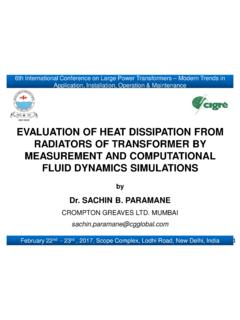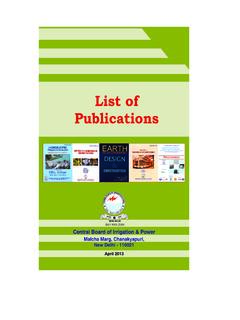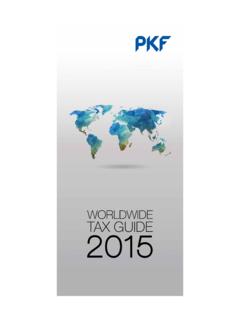Transcription of SUBSTATIONS - Central Board of Irrigation and Power
1 SUBSTATIONS . In the Power System of the Future Terry Krieg Chairman CIGRE Study Committee B3 - SUBSTATIONS SUBSTATIONS . In the Power System of the Future Terry Krieg Chairman CIGRE Study Committee B3 - SUBSTATIONS Overview Background CIGRE Study Committee B3 Activities Challenges in Industry Trends in Substation Development The Future Substation Questions The big picture - global influences Background World Energy Consumption Continued growth in demand expected Climate change impacts? Energy Growth Rate to 2035. Growth in demand: domestic, mining and industry Asset renewal and refurbishment Significant increase in infrastructure is required Australian Productivity Combined water, gas, water and waste Source the Australian Bureau of Statistics Australian Productivity Ranked 27th in quality of electricity supply (source WEF). Not as good as we thought? Common Problems Labour: Labour costs Increased level of management Skill shortages, staff retention Staff (and consultant) resistance to change!
2 De-engineering of organisations, reducing innovation Capital Delivery: Regulatory environment Industry unbundling and privatisation process Design standards & procurement options We need fast delivery, minimised, predictable costs We need to do more with less! Representing the Power industry CIGR . Who is CIGR ? Conseil International des Grands R seaux lectriques International Council On Large Electric Systems Founded in Paris in 1921. Worldwide non-profit association. Addresses issues related to the development, operation and management of electric Power systems Design, construction, maintenance and disposal of equipment and plants. 8000 members in 89 countries CIGRE Technical Committees Technical Committee A : EQUIPMENT B : SUBSYSTEMS C : SYSTEM D : HORIZONTAL. SC A1 Rotating Electrical SC C1 System SC D1 Materials &. SC B1 Insulated Cables Machines Development & Economics Emerging Test Techniques SC C2 System Operation SC D2 Information Systems SC A2 Transformers SC B2 Overhead Lines & Control & Telecommunication SC A3 High Voltage SC C3 System SC B3 SUBSTATIONS Equipment Environmental Performance SC B4 HVDC & Power SC C4 System Technical Electronics Performance SC B5 Protection & SC C5 Electricity Markets Automation & Regulation SC C6 Distributed Systems & Dispersed Generation SC B3 Structure Strategic Advisory Group Customer Advisory Group SC B3 Chairman SC B3 Secretary Tutorial Advisory Group Study Committee 24 Regular Members, 14 Observer Members, 2 Special Reporter, all WB Convenors Reducing replacement time of HV SF6 analysis for AIS.
3 GIS and MTS condition Air insulated SUBSTATIONS design for severe Expected impact of future grid concept on Equipment assessment climate condition substation management B3/C1 Field test technology on UHV substation Saving through optimized maintenance of Circuit Configuration Optimisation construction and operation Air insulated SUBSTATIONS Special Considerations for AC Collector guide to minimize the use of SF6 during Systems and SUBSTATIONS associated with routine testing of electrical equipment HVDC connected Wind Powers Plants JWG B3 Substation earthing system design Factors for investment decision GIL vs. optimisation through the application of Cables for AC Transmission quantified risk analysis WG Benefits of PD diagnosis on GIS condition assessment WG Internal arc effects in medium voltage switchgear (1-52kV) - mitigation techniques B1 Feasability of a common dry type interface for GIS and Power cables of 52 kV and above SC B3 Membership Study Committee B3.
4 Mission: To facilitate and promote the progress of engineering International exchange of information and knowledge Add value to this information and knowledge by: Synthesizing state-of-the-art practices and Developing recommendations and providing best practice. Scope: Design, construction, maintenance and management Technical, economic, environmental and social aspects for stakeholders Increased reliability and availability, cost effective solutions, managed environmental impact, effective asset management. Requires effective relationships with other SC s Preferential Subjects 2014. PS 1 : Substation Developments to address future needs Integration of new approaches to grid automation in Transmission and Distribution SUBSTATIONS Impact of new grid developments on substation design Off shore SUBSTATIONS Low cost and fast deployment distribution SUBSTATIONS PS2 : Life-cycle management of SUBSTATIONS Renovation, refurbishment, extension and up-rating Asset management, maintenance, monitoring, reliability and sustainability issues Managing risk in design, installation and operation SC B3 Brochures Combining Innovation with Standardisation 389.
5 Obtaining value from Substation Condition Monitoring 462. Cost Reductions of Air Insulated SUBSTATIONS 354. Primary /Secondary system interface modelling for total asset 472. performance optimization Residual Life Concepts Applied to HV GIS 499. Mixed Technologies Switchgear MTS 390. SF6 Tightness guide 430. Turnkey SUBSTATIONS 439. Tech. requirements for SUBSTATIONS exceeding 800kV 400. Guidelines for uprating and upgrading of SUBSTATIONS 532. Guidelines For The Design And Construction Of AC Offshore 483. SUBSTATIONS For Wind Farms Field Tests for UHV SUBSTATIONS 562. SF6 Analysis for AIS, GIS and MTS Condition Assessment 567. Circuit Configuration Optimisation (JWG). IT Strategies for AM of SUBSTATIONS -General principles Events Life wasn t meant to easy .. Challenges Some global challenges Increasing demand in some countries megacities Integration of renewables and embedded generation Industry restructuring and regulation Cyber security Severe weather conditions Design standards and lack of innovation Aging assets Skill shortages, retention, Resistance to change Generation Y (born 1980 -1995).
6 Some Utility challenges Environment Reduce emissions of (CO2, ). Sound, visual impact, . Interior (Personel safety). Exterior (Third party safety). Stakeholders Profitability Increased customer services Reduce maintenance costs Reliability Utility Reduce outages Political pressure Minimize penalties Investment decisions Image Ellagen Legislation Health & Safety Report inventory of SF6. SF6 leakage limited by law (California). Import tax (Australia). Trend 1. Standardisation to achieve innovation Traditional Design Standards Design using Design Manual, Specifications, Internal Standards, AS standards etc. Project Needs identified Procurement and delivery stage Result: Stifled innovation, Outcome not matched to needs or strategic objectives Tailored solution, long delivery time Lack of skills to manage Design Manual changes Even the CEO can t change standards! Standards What we aim for? Reduce cost, reduce delivery time Add predictability and certainty Justification of design approaches Standard Designs rather than Design Standards.
7 Advantages: Optimised design to balance corporate objectives Reduced cost, optimised procurement More flexibility but with Standard advantages Documented and justified designs Step innovation Easier to manage with broad skill base Standard design approach Base Documents Templates Current Design Substation Design State Policies Primary CAPEX Functional Review Specific- ations Secondary Future Concept State Design Vision Civil Reference Tech Tech Tech Tech Tech Tech Design Stds. Tech Specs. Other Specs. Stds. Manual Specs. Specs. Specs. Docs. Standard Designs in Ergon Distribution company: <220kV. Load growth and refurbishment New substation designs: AIS, GIS variations Skid, Modular, Mobile Standardised design elements Long term procurement contracts Implemented broader corporate aims TB389. Trend 2. SMART Grids Traditional Topology Source: Hans-Erik Olovsson, SC B3/AA1 2011. Future Networks Centralised and distributed generation Micro-grids Intermittent generation (wind/solar).
8 Multi-directional Power flow Load adapted to production Operations based more on real-time data Energy Storage! Source: Hans-Erik Olovsson, SC B3/AA1 2011. Energy Storage Source: Peter Terwiesch, Opening Panel CIGRE 2010. Trend 3. 61850 Development One Protocol for SUBSTATIONS The international Goal IEC 61850. Experience from earlier standardisation both in USA and Europe Combines best of many existing protocols IEC 61850-8-1 - Station Bus Almost all transmission utilities use (or are considering). IEC 61850-8-1 protocol today;. Very fast transition from proprietary protocols Aim for open architecture (using Intelligent Electronic devices (IEDs) from different manufacturers connected to the same station bus). IEC 61850-8-1 also enables splitting between function and physical location IEC 61850-8-1. GOOSE. 61850 The digital substation Source: Hans-Erik Olovsson, SC B3/AA1 2011. 61850-8-2 - Process Bus This is next step and a more revolutionary change, (1A/110 V to fibre optic).
9 All copper cable, except for Power feeding, changed to fibre optics Many pilots installed around the world First commercial delivery was in Australia - Powerlink Enabler for introduction of Non Conventional Instrument Transformers (NCIT). IEC 61850-8-2 - Process Bus NCIT Development Process bus enables introduction of NCIT using fibre optic sensors Environmental friendly no copper, steel, iron, concrete, insulation material, etc. NCIT will be possible to integrate into high voltage apparatus and further reduce the footprint of substation Merging units on NCIT transfer sensor signals to 9-2. protocol Advantages: Reduced substation environmental footprint Design and construction savings Trend 4. Plant technology and materials changes Air Insulated Substation evolution Source: Hans-Erik Olovsson, SC B3/AA1 2011. Primary Design Changes Historically AIS SUBSTATIONS were designed for high frequency CB maintenance, Single line configuration built with CB s surrounded by disconnectors Source: Hans-Erik Olovsson, SC B3/AA1 2011.
10 Evolution of CB s and DS s 420 kV Air blast 420 kV Minimum Oil 420 kV SF6 CB. Modern CB s maintenance 15 years+, AIS DS s unchanged Maintenance Rate (primary system). Bulk Oil Breakers Air blast Breakers Minimum Oil breakers Disconnectors with 4 chambers/170 kV. open contacts SF6 Breakers SF6 Breakers 1950 2000 2 Chambers/170 kV 1 Chamber/245 kV. Vacuum 1950 2000. Source: Hans-Erik Olovsson, SC B3/AA1 2011. Disconnecting Circuit Breaker Combines the disconnecting function with CB. Reduces substation footprint Extends maintenance intervals Higher overall availability Source: Hans-Erik Olovsson, SC B3/AA1 2011. Hybrid Disconnecting DS CB. CT DCB. CT. BB BB. ES VT ES VT. 43. Source: Hans-Erik Olovsson, SC B3/AA1 2011. Rotating Withdrawable 44. Source: Hans-Erik Olovsson, SC B3/AA1 2011. Gas Insulated Switchgear Increasing production and installation Lifetime of early designs more than the design life of 25-30. years - today s expectation: >40 years No generic life limiting mechanisms have been reported so far Source: CIGRE SC B3 WG17 - AA2 Residual Life Tutorial SF6 Usage Worldwide Polymer Nanocomposites Nano-composites Interfaces and Interactio Now being applied to spacers in GIS.











